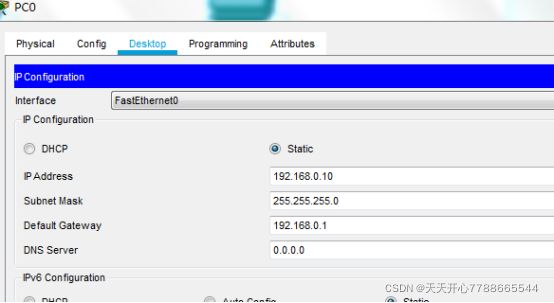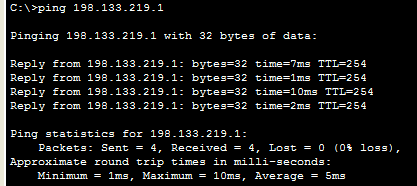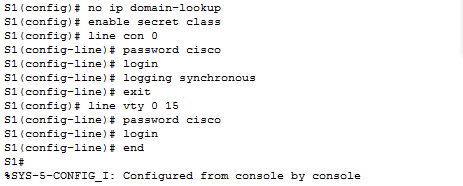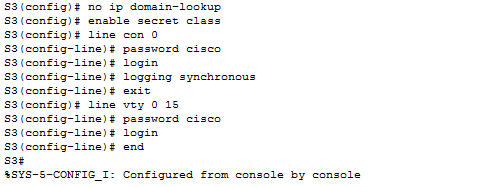实验 – 配置 IPv4 静态路由和默认路由(教师版)步骤在末尾,报告结束以后(二十步解决,不用听课,闭着眼照着步骤做就没问题)
实验 – 配置 IPv4 静态路由和默认路由(教师版)
教师注意事项:红色字体或灰色突显的部分表示仅显示在教师副本上的文本。
拓扑
地址分配表
设备 接口 IP 地址 子网掩码 默认网关
R1 G0/1 192.168.0.1 255.255.255.0 N/A
S0/0/1 10.1.1.1 255.255.255.252 N/A
R3 G0/1 192.168.1.1 255.255.255.0 N/A
S0/0/0 (DCE) 10.1.1.2 255.255.255.252 N/A
Lo0 209.165.200.225 255.255.255.224 N/A
Lo1 198.133.219.1 255.255.255.0 N/A
PC-A NIC 192.168.0.10 255.255.255.0 192.168.0.1
PC-C NIC 192.168.1.10 255.255.255.0 192.168.1.1
目标
第 1 部分:设置拓扑并初始化设备
第 2 部分:配置基本设备设置并检验连接
第 3 部分:配置静态路由
配置递归静态路由。
配置直连静态路由。
配置并删除静态路由。
第 4 部分:配置并检验默认路由
背景/场景
路由器使用路由表来确定将数据包发送到何处。路由表包含一组路由,描述路由器使用哪个网关或接口到达指定网络。最初,路由表只包含直接连接的网络。要与远程网络通信,则必须指定路由并将其添加到路由表中。
在本实验中,您将根据下一跳 IP 地址或送出接口手动配置指向指定远程网络的静态路由。还将配置静态默认路由。默认路由是一种静态路由,指定当路由表不含到达目的网络的路径时应使用的网关。
注意:本实验为配置静态路由所需实际命令提供最少协助。但是所需命令在附录 A 中。尝试在不参考附录的情况下配置设备,测验您的知识掌握程度。
注意:CCNA 动手实验所用的路由器是采用 Cisco IOS Release 15.2(4)M3(universalk9 映像)的 Cisco 1941 集成多业务路由器 (ISR)。所用的交换机是采用 Cisco IOS Release 15.0(2)(lanbasek9 映像)的 Cisco Catalyst 2960 系列。也可使用其他路由器、交换机以及 Cisco IOS 版本。根据型号以及 Cisco IOS 版本不同,可用命令和产生的输出可能与实验显示的不一样。请参考本实验末尾的“路由器接口摘要表”以了解正确的接口标识符。
注意:确保所使用的路由器和交换机的启动配置都已擦除。如果不确定,请联系教师。
教师注意事项:请参阅“教师实验手册”了解初始化和重新加载设备的程序。
所需资源
2 台路由器(支持 Cisco IOS 15.2(4)M3 版通用映像的 Cisco 1941 或同类路由器)
2 台交换机(支持 Cisco IOS 版本 15.0(2) lanbasek9 映像的 Cisco 2960 或同类交换机)
2 台 PC(采用 Windows 7、Vista 或 XP 且支持终端模拟程序,比如 Tera Term)
用于通过控制台电缆配置 Cisco IOS 设备的控制台端口
如拓扑所示的以太网电缆和串行电缆
第 1 部分:设置拓扑并初始化设备
第 1 步:建立如拓扑图所示的网络。
第 2 步:初始化并重新加载路由器和交换机。
第 2 部分:配置基本设备设置并检验连接
在第 2 部分,您将会配置基本设置,例如接口 IP 地址、设备访问和密码。您将检验 LAN 连接并确定 R1 和 R3 的路由表中列出的路由。
第 1 步:配置 PC 接口。
第 2 步:配置路由器的基本设置。
a.如拓扑和地址分配表所示配置设备名称。
b.禁用 DNS 查找。
c.指定 class 作为使能密码,指定 cisco 作为控制台和 vty 密码。
d.将运行配置保存到启动配置文件中。
第 3 步:配置路由器上的 IP 设置。
a.根据地址分配表为 R1 和 R3 接口接口配置 IP 地址。
b.S0/0/0 的连接为 DCE 连接,要求使用 clock rate 命令。R3 S0/0/0 的配置显示如下。
教师注意事项:Cisco 1941 路由器会自动检测 DCE,而且时钟频率自动设置为 2000000,无需进行配置。
R3(config)# interface s0/0/0
R3(config-if)# ip address 10.1.1.2 255.255.255.252
R3(config-if)# clock rate 128000
R3(config-if)# no shutdown
第 4 步:检验 LAN 连接。
a.从每台 PC 对为该主机配置的默认网关执行 ping 操作来测试连接。
在 PC-A 上能否对默认网关执行 ping 操作?可以
在 PC-C 上能否对默认网关执行 ping 操作?可以
b.通过在直接连接的路由器之间执行 ping 操作来测试连接。
从 R1,能否对 R3 的 S0/0/0 接口执行 ping 操作?可以
如果有任何问题的答案是否定的,请对配置进行排除故障并纠正错误。
c.测试未直接连接的设备之间的连通性。
在 PC-A 上是否能对 PC-C 执行 ping 操作?不可以
在 PC-A 上是否能对 Lo0 执行 ping 操作? 不可以
在 PC-A 上是否能对 Lo1 执行 ping 操作?不可以
这些 ping 是否成功?原因是什么?
因为没有配置路由表,所以在到达路由器的时候找不到路由表
注意:PC 之间执行 ping 操作可能需要禁用 PC 防火墙。
第 5 步:收集信息。
a.使用 show ip interface brief 命令检查 R1 的接口状态。
R1# show ip interface brief
Interface IP-Address OK? Method Status Protocol
Embedded-Service-Engine0/0 unassigned YES unset administratively down down
GigabitEthernet0/0 unassigned YES unset administratively down down
GigabitEthernet0/1 192.168.0.1 YES manual up up
Serial0/0/0 unassigned YES unset administratively down down
Serial0/0/1 10.1.1.1 YES manual up up
R1 上激活了多少个接口?2
b.检查 R3 的接口状态。
R3# show ip interface brief
Interface IP-Address OK? Method Status Protocol
Embedded-Service-Engine0/0 unassigned YES unset administratively down down
GigabitEthernet0/0 unassigned YES unset administratively down down
GigabitEthernet0/1 192.168.1.1 YES manual up up
Serial0/0/0 10.1.1.2 YES manual up up
Serial0/0/1 unassigned YES unset administratively down down
Loopback0 209.165.200.225 YES manual up up
Loopback1 198.133.219.1 YES manual up up
R3 上激活了多少个接口?4
c.使用 show ip route 命令查看 R1 的路由表信息。
R1# show ip route
Codes: L - local, C - connected, S - static, R - RIP, M - mobile, B - BGP
D - EIGRP, EX - EIGRP external, O - OSPF, IA - OSPF inter area
N1 - OSPF NSSA external type 1, N2 - OSPF NSSA external type 2
E1 - OSPF external type 1, E2 - OSPF external type 2
i - IS-IS, su - IS-IS summary, L1 - IS-IS level-1, L2 - IS-IS level-2
ia - IS-IS inter area, * - candidate default, U - per-user static route
o - ODR, P - periodic downloaded static route, H - NHRP, l - LISP
+ - replicated route, % - next hop override
Gateway of last resort is not set
10.0.0.0/8 is variably subnetted, 2 subnets, 2 masks
C 10.1.1.0/30 is directly connected, Serial0/0/1
L 10.1.1.1/32 is directly connected, Serial0/0/1
192.168.0.0/24 is variably subnetted, 2 subnets, 2 masks
C 192.168.0.0/24 is directly connected, GigabitEthernet0/1
L 192.168.0.1/32 is directly connected, GigabitEthernet0/1
哪些网络存在于本实验的地址分配表中,但不在 R1 的路由表中?
C 192.168.0.0/24 is directly connected, GigabitEthernet0/1
d.查看 R3 的路由表信息。
R3# show ip route
Codes: L - local, C - connected, S - static, R - RIP, M - mobile, B - BGP
D - EIGRP, EX - EIGRP external, O - OSPF, IA - OSPF inter area
N1 - OSPF NSSA external type 1, N2 - OSPF NSSA external type 2
E1 - OSPF external type 1, E2 - OSPF external type 2
i - IS-IS, su - IS-IS summary, L1 - IS-IS level-1, L2 - IS-IS level-2
ia - IS-IS inter area, * - candidate default, U - per-user static route
o - ODR, P - periodic downloaded static route, H - NHRP, l - LISP
+ - replicated route, % - next hop override
Gateway of last resort is not set
10.0.0.0/8 is variably subnetted, 2 subnets, 2 masks
C 10.1.1.0/30 is directly connected, Serial0/0/0
L 10.1.1.2/32 is directly connected, Serial0/0/0
192.168.1.0/24 is variably subnetted, 2 subnets, 2 masks
C 192.168.1.0/24 is directly connected, GigabitEthernet0/1
L 192.168.1.1/32 is directly connected, GigabitEthernet0/1
198.133.219.0/24 is variably subnetted, 2 subnets, 2 masks
C 198.133.219.0/24 is directly connected, Loopback1
L 198.133.219.1/32 is directly connected, Loopback1
209.165.200.0/24 is variably subnetted, 2 subnets, 2 masks
C 209.165.200.224/27 is directly connected, Loopback0
L 209.165.200.225/32 is directly connected, Loopback0
哪些网络存在于本实验的地址分配表中,但不在 R3 的路由表中?
为什么并非所有网络都在这些路由器的路由表中?
第 3 部分:配置静态路由
在第 3 部分,您将采用多种方式实施静态和默认路由,确认路由已添加到 R1 和 R3 的路由表中,而且您将根据引入的路由检验连接。
注意:本实验为配置静态路由所需实际命令提供最少协助。但是所需命令在附录 A 中。尝试在不参考附录的情况下配置设备,测验您的知识掌握程度。
第 1 步:配置递归静态路由。
在递归静态路由中,会指定下一跳 IP 地址。由于只指定了下一跳 IP,因此路由器必须在路由表中执行多次查找才能转发数据包。要配置递归静态路由,请使用以下语法:
Router(config)# ip route network-address subnet-mask ip-address
a.在 R1 路由器上,配置通往 192.168.1.0 网络的静态路由(使用 R3 Serial 0/0/0 接口的 IP 地址作为下一跳地址)。在下面空白处写下您使用的命令。
R1(config)# ip route 192.168.1.0 255.255.255.0 10.1.1.2
b.查看路由表,检验新添加的静态路由条目。
R1# show ip route
Codes: L - local, C - connected, S - static, R - RIP, M - mobile, B - BGP
D - EIGRP, EX - EIGRP external, O - OSPF, IA - OSPF inter area
N1 - OSPF NSSA external type 1, N2 - OSPF NSSA external type 2
E1 - OSPF external type 1, E2 - OSPF external type 2
i - IS-IS, su - IS-IS summary, L1 - IS-IS level-1, L2 - IS-IS level-2
ia - IS-IS inter area, * - candidate default, U - per-user static route
o - ODR, P - periodic downloaded static route, H - NHRP, l - LISP
+ - replicated route, % - next hop override
Gateway of last resort is not set
10.0.0.0/8 is variably subnetted, 2 subnets, 2 masks
C 10.1.1.0/30 is directly connected, Serial0/0/1
L 10.1.1.1/32 is directly connected, Serial0/0/1
192.168.0.0/24 is variably subnetted, 2 subnets, 2 masks
C 192.168.0.0/24 is directly connected, GigabitEthernet0/1
L 192.168.0.1/32 is directly connected, GigabitEthernet0/1
S 192.168.1.0/24 [1/0] via 10.1.1.2
新的路由如何列在路由表中?
C 192.168.0.0/24 is directly connected, GigabitEthernet0/1
在主机 PC-A 上,是否能对主机 PC-C 执行 ping 操作?不能
这些 ping 会失败。如果递归静态路由配置正确,ping 可到达 PC-C。PC-C 将对 PC-A 发回 ping 应答。然而,ping 应答在 R3 上将被丢弃,因为 R3 的路由表中没有通往 192.168.0.0 网络的返回路由。
第 2 步:配置直连静态路由。
使用直连静态路由时,会指定 exit-interface 参数,允许路由器通过一次查找做出转发决策。直连静态路由通常用于点对点串行接口。要使用指定的送出接口配置直连静态路由,请使用以下语法:
Router(config)# ip route network-address subnet-mask exit-intf
a.在 R3 路由器上,使用 S0/0/0 作为送出接口配置通往 192.168.0.0 网络的静态路由。在下面空白处写下您使用的命令。
R3(config)# ip route 192.168.0.0 255.255.255.0 s0/0/0
b.查看路由表,检验新添加的静态路由条目。
R3# show ip route
Codes: L - local, C - connected, S - static, R - RIP, M - mobile, B - BGP
D - EIGRP, EX - EIGRP external, O - OSPF, IA - OSPF inter area
N1 - OSPF NSSA external type 1, N2 - OSPF NSSA external type 2
E1 - OSPF external type 1, E2 - OSPF external type 2
i - IS-IS, su - IS-IS summary, L1 - IS-IS level-1, L2 - IS-IS level-2
ia - IS-IS inter area, * - candidate default, U - per-user static route
o - ODR, P - periodic downloaded static route, H - NHRP, l - LISP
+ - replicated route, % - next hop override
Gateway of last resort is not set
10.0.0.0/8 is variably subnetted, 2 subnets, 2 masks
C 10.1.1.0/30 is directly connected, Serial0/0/0
L 10.1.1.2/32 is directly connected, Serial0/0/0
S 192.168.0.0/24 is directly connected, Serial0/0/0
192.168.1.0/24 is variably subnetted, 2 subnets, 2 masks
C 192.168.1.0/24 is directly connected, GigabitEthernet0/1
L 192.168.1.1/32 is directly connected, GigabitEthernet0/1
198.133.219.0/24 is variably subnetted, 2 subnets, 2 masks
C 198.133.219.0/24 is directly connected, Loopback1
L 198.133.219.1/32 is directly connected, Loopback1
209.165.200.0/24 is variably subnetted, 2 subnets, 2 masks
C 209.165.200.224/27 is directly connected, Loopback0
L 209.165.200.225/32 is directly connected, Loopback0
新的路由如何列在路由表中?
S 192.168.0.0/24 is directly connected, Serial0/0/0
c.在主机 PC-A 上,是否能对主机 PC-C 执行 ping 操作?可以
注意:PC 之间执行 ping 操作可能需要禁用 PC 防火墙。
第 3 步:配置静态路由。
a.在 R1 路由器上,使用上述步骤中的静态路由配置选项之一配置通往 198.133.219.0 网络的静态路由。在下面空白处写下您使用的命令。
R1(config)# ip route 198.133.219.0 255.255.255.0 S0/0/1
b.在 R1 路由器上,使用上述步骤中的另一个静态路由配置选项配置通往 R3 上的 209.165.200.224 网络的静态路由。在下面空白处写下您使用的命令。
R1(config)# ip route 209.165.200.224 255.255.255.224 S0/0/1
or
R1(config)# ip route 209.165.200.224 255.255.255.224 10.1.1.2
c.查看路由表,检验新添加的静态路由条目。
注意:根据已配置的静态路由类型,学生可能会得出不同的路由表输出。
R1# show ip route
Codes: L - local, C - connected, S - static, R - RIP, M - mobile, B - BGP
D - EIGRP, EX - EIGRP external, O - OSPF, IA - OSPF inter area
N1 - OSPF NSSA external type 1, N2 - OSPF NSSA external type 2
E1 - OSPF external type 1, E2 - OSPF external type 2
i - IS-IS, su - IS-IS summary, L1 - IS-IS level-1, L2 - IS-IS level-2
ia - IS-IS inter area, * - candidate default, U - per-user static route
o - ODR, P - periodic downloaded static route, H - NHRP, l - LISP
+ - replicated route, % - next hop override
Gateway of last resort is not set
10.0.0.0/8 is variably subnetted, 2 subnets, 2 masks
C 10.1.1.0/30 is directly connected, Serial0/0/1
L 10.1.1.1/32 is directly connected, Serial0/0/1
192.168.0.0/24 is variably subnetted, 2 subnets, 2 masks
C 192.168.0.0/24 is directly connected, GigabitEthernet0/1
L 192.168.0.1/32 is directly connected, GigabitEthernet0/1
S 192.168.1.0/24 [1/0] via 10.1.1.2
S 198.133.219.0/24 is directly connected, Serial0/0/1
209.165.200.0/27 is subnetted, 1 subnets
S 209.165.200.224 [1/0] via 10.1.1.2
新的路由如何列在路由表中?
S 198.133.219.0/24 is directly connected, Serial0/0/1
d.从主机 PC-A,能否对 R1 地址 198.133.219.1 执行 ping 操作?可以
第 4 步:删除环回地址的静态路由。
a.在 R1 上,使用 no 命令删除路由表中两个环回地址的静态路由。在下面空白处写下您使用的命令。
R1(config)# no ip route 209.165.200.224 255.255.255.224 10.1.1.2
R1(config)# no ip route 198.133.219.0 255.255.255.0 S0/0/1
注意:如下所示,可使用 no 命令删除静态路由,无需指定送出接口或下一跳 IP 地址。
R1(config)# no ip route 209.165.200.224 255.255.255.224
R1(config)# no ip route 198.133.219.0 255.255.255.0
b.查看路由表以检验路由是否已删除。
R1# show ip route
Codes: L - local, C - connected, S - static, R - RIP, M - mobile, B - BGP
D - EIGRP, EX - EIGRP external, O - OSPF, IA - OSPF inter area
N1 - OSPF NSSA external type 1, N2 - OSPF NSSA external type 2
E1 - OSPF external type 1, E2 - OSPF external type 2
i - IS-IS, su - IS-IS summary, L1 - IS-IS level-1, L2 - IS-IS level-2
ia - IS-IS inter area, * - candidate default, U - per-user static route
o - ODR, P - periodic downloaded static route, H - NHRP, l - LISP
+ - replicated route, % - next hop override
Gateway of last resort is not set
10.0.0.0/8 is variably subnetted, 2 subnets, 2 masks
C 10.1.1.0/30 is directly connected, Serial0/0/1
L 10.1.1.1/32 is directly connected, Serial0/0/1
192.168.0.0/24 is variably subnetted, 2 subnets, 2 masks
C 192.168.0.0/24 is directly connected, GigabitEthernet0/1
L 192.168.0.1/32 is directly connected, GigabitEthernet0/1
S 192.168.1.0/24 [1/0] via 10.1.1.2
R1 的路由表中列出了多少条网络路由?三条
是否设置了最后选用网关?否
第 4 部分:配置并检验默认路由
在第 4 部分,您将实施默认路由,确认路由已添加到路由表中,并根据引入的路由检验连接。
在没有获取的路由或静态路由的情况下,默认路由用于确定发送所有 IP 数据包的网关。默认静态路由是将 0.0.0.0 作为目的 IP 地址和子网掩码的静态路由。通常将其称为“全零”路由。
在默认路由中,可以指定下一跳 IP 地址或送出接口。要配置默认静态路由,请使用以下语法:
Router(config)# ip route 0.0.0.0 0.0.0.0 {ip-address or exit-intf}
a.使用送出接口 S0/0/1 为 R1 路由器配置默认路由。在下面空白处写下您使用的命令。
R1(config)# ip route 0.0.0.0 0.0.0.0 s0/0/1
b.查看路由表,检验新添加的静态路由条目。
R1#show ip route
Codes: L - local, C - connected, S - static, R - RIP, M - mobile, B - BGP
D - EIGRP, EX - EIGRP external, O - OSPF, IA - OSPF inter area
N1 - OSPF NSSA external type 1, N2 - OSPF NSSA external type 2
E1 - OSPF external type 1, E2 - OSPF external type 2
i - IS-IS, su - IS-IS summary, L1 - IS-IS level-1, L2 - IS-IS level-2
ia - IS-IS inter area, * - candidate default, U - per-user static route
o - ODR, P - periodic downloaded static route, H - NHRP, l - LISP
+ - replicated route, % - next hop override
Gateway of last resort is 0.0.0.0 to network 0.0.0.0
S* 0.0.0.0/0 is directly connected, Serial0/0/1
10.0.0.0/8 is variably subnetted, 2 subnets, 2 masks
C 10.1.1.0/30 is directly connected, Serial0/0/1
L 10.1.1.1/32 is directly connected, Serial0/0/1
192.168.0.0/24 is variably subnetted, 2 subnets, 2 masks
C 192.168.0.0/24 is directly connected, GigabitEthernet0/1
L 192.168.0.1/32 is directly connected, GigabitEthernet0/1
S 192.168.1.0/24 [1/0] via 10.1.1.2
新的路由如何列在路由表中?
S* 0.0.0.0/0 is directly connected, Serial0/0/1
最后选用网关是什么?
Gateway of last resort is 0.0.0.0 to network 0.0.0.0
c.从主机 PC-A 能否对 209.165.200.225 执行 ping 操作?可以
d.从主机 PC-A 能否对 198.133.219.1 执行 ping 操作?可以
思考
1.一个新网络 192.168.3.0/24 连接到 R1 上的接口 G0/0。可以使用什么命令配置从 R3 指向该网络的静态路由?
R3(config)# ip route 192.168.3.0 255.255.255.0 g0/0/0
2.配置直连静态路由而非递归静态路由有什么优点?
快,不需要多次递归,但是如果中间存在其他网络静态网络就不适用了
3.为什么在路由器上配置默认路由很重要?
因为如果没有默认路由 包的目的地址与路由表总没有匹配表象将会被丢弃
路由器接口摘要表
路由器接口摘要
路由器型号 Ethernet Interface #1 Ethernet Interface #2 Serial Interface #1 Serial Interface #2
1800 Fast Ethernet 0/0 (F0/0) Fast Ethernet 0/1 (F0/1) Serial 0/0/0 (S0/0/0) Serial 0/0/1 (S0/0/1)
1900 Gigabit Ethernet 0/0 (G0/0) Gigabit Ethernet 0/1 (G0/1) Serial 0/0/0 (S0/0/0) Serial 0/0/1 (S0/0/1)
2801 Fast Ethernet 0/0 (F0/0) Fast Ethernet 0/1 (F0/1) Serial 0/1/0 (S0/1/0) Serial 0/1/1 (S0/1/1)
2811 Fast Ethernet 0/0 (F0/0) Fast Ethernet 0/1 (F0/1) Serial 0/0/0 (S0/0/0) Serial 0/0/1 (S0/0/1)
2900 Gigabit Ethernet 0/0 (G0/0) Gigabit Ethernet 0/1 (G0/1) Serial 0/0/0 (S0/0/0) Serial 0/0/1 (S0/0/1)
注意:若要了解如何配置路由器,请查看接口来确定路由器类型以及路由器拥有的接口数量。我们无法为每类路由器列出所有的配置组合。下表列出了设备中以太网和串行接口组合的标识符。此表中未包含任何其他类型的接口,但实际的路由器可能会含有其他接口。例如 ISDN BRI 接口。括号中的字符串是约定缩写,可在 Cisco IOS 命令中用来代表接口。
附录 A:第 2、第 3 和第 4 部分所需的配置命令
附录 A 中列出的命令仅供参考。此附录并不包含完成本实验所需的所有特定命令。
设备的基本设置
配置路由器上的 IP 设置。
R3(config)# interface s0/0/0
R3(config-if)# ip address 10.1.1.2 255.255.255.252
R3(config-if)# clock rate 128000
R3(config-if)# no shutdown
静态路由配置
配置递归静态路由。
R1(config)# ip route 192.168.1.0 255.255.255.0 10.1.1.2
配置直连静态路由。
R3(config)# ip route 192.168.0.0 255.255.255.0 s0/0/0
删除静态路由。
R1(config)# no ip route 209.165.200.224 255.255.255.224 serial0/0/1
R1(config)# no ip route 209.165.200.224 255.255.255.224 10.1.1.2
R1(config)# no ip route 209.165.200.224 255.255.255.224
默认路由配置
R1(config)# ip route 0.0.0.0 0.0.0.0 s0/0/1
设备配置 - R1 和 R3
路由器 R1(第 4 部分之后)
R1#show run
Building configuration…
Current configuration : 1547 bytes
!
version 15.2
service timestamps debug datetime msec
service timestamps log datetime msec
service password-encryption
!
hostname R1
!
boot-start-marker
boot-end-marker
!
!
enable secret 4 06YFDUHH61wAE/kLkDq9BGho1QM5EnRtoyr8cHAUg.2
!
no aaa new-model
!
!
!
!
!
!
!
no ip domain lookup
ip cef
no ipv6 cef
!
multilink bundle-name authenticated
!
!
!
!
!
!
redundancy
!
!
!
!
!
! interface Embedded-Service-Engine0/0
no ip address
shutdown
!
!
interface GigabitEthernet0/0
no ip address
shutdown
duplex auto
speed auto
!
interface GigabitEthernet0/1
ip address 192.168.0.1 255.255.255.0
duplex auto
speed auto
!
interface Serial0/0/0
no ip address
shutdown
clock rate 2000000
!
interface Serial0/0/1
ip address 10.1.1.1 255.255.255.252
!
ip forward-protocol nd
!
no ip http server
no ip http secure-server
!
ip route 0.0.0.0 0.0.0.0 Serial0/0/1
ip route 192.168.1.0 255.255.255.0 10.1.1.2
!
!
!
!
control-plane
!
!
banner motd ^CUnauthorized access prohibited!^C
!
line con 0
password 7 01100F175804
logging synchronous
login
line aux 0
line 2
no activation-character
no exec
transport preferred none
transport input all
transport output pad telnet rlogin lapb-ta mop udptn v120 ssh
stopbits 1
line vty 0 4
password 7 01100F175804
logging synchronous
login
transport input all
!
scheduler allocate 20000 1000
!
end
路由器 R3
R3#show run
Building configuration…
Current configuration : 1700 bytes
!
version 15.2
service timestamps debug datetime msec
service timestamps log datetime msec
service password-encryption
!
hostname R3
!
boot-start-marker
boot-end-marker
!
!
enable secret 4 06YFDUHH61wAE/kLkDq9BGho1QM5EnRtoyr8cHAUg.2
!
no aaa new-model
memory-size iomem 15
!
!
!
!
!
!
!
no ip domain lookup
ip cef
no ipv6 cef
!
multilink bundle-name authenticated
!
!
!
!
!
vtp domain TSHOOT
vtp mode transparent
!
redundancy
!
!
!
!
!
!
!
!
!
!
!
!
!
!
interface Loopback0
ip address 209.165.200.225 255.255.255.224
!
interface Loopback1
ip address 198.133.219.1 255.255.255.0
!
interface Embedded-Service-Engine0/0
no ip address
shutdown
!
interface GigabitEthernet0/0
no ip address
shutdown
duplex auto
speed auto
!
interface GigabitEthernet0/1
ip address 192.168.1.1 255.255.255.0
duplex auto
speed auto
!
interface Serial0/0/0
ip address 10.1.1.2 255.255.255.252
clock rate 256000
!
interface Serial0/0/1
no ip address
shutdown
!
ip forward-protocol nd
!
no ip http server
no ip http secure-server
!
ip route 192.168.0.0 255.255.255.0 Serial0/0/0
!
!
!
!
control-plane
!
!
banner motd ^CUnauthorized access prohibited!^C
!
line con 0
password 7 110A1016141D
logging synchronous
login
line aux 0
line 2
no activation-character
no exec
transport preferred none
transport input all
transport output pad telnet rlogin lapb-ta mop udptn v120 ssh
stopbits 1
line vty 0 4
password 7 00071A150754
logging synchronous
login
transport input all
!
scheduler allocate 20000 1000
!
End
附录 A:初始化并重新加载路由器和交换机
第 2 步:初始化并重新加载路由器。
a.通过控制台连接到路由器并启用特权 EXEC 模式。
Router> enable
Router#
b.键入 erase startup-config 命令从 NVRAM 中删除启动配置。
Router# erase startup-config
Erasing the nvram filesystem will remove all configuration files! Continue? [confirm]
[OK]
Erase of nvram: complete
Router#
c.发出 reload 命令,删除内存中的旧配置。当提示是否 Proceed with reload 时,按 Enter 确认重新加载。(按其他任意键中止重新加载。)
Router# reload
Proceed with reload? [confirm]
*Nov 29 18:28:09.923: %SYS-5-RELOAD: Reload requested by console. Reload Reason: Reload Command.
注意:系统可能会提示您在重新加载路由器之前保存运行配置。键入 no 并按 Enter 键。
System configuration has been modified. Save? [yes/no]: no
d.重新加载路由器后,系统会提示您进入初始配置对话框。输入 no 并按 Enter 键。
Would you like to enter the initial configuration dialog? [yes/no]: no
e.系统将提示您终止自动安装。键入 yes,然后按 Enter 键。
Would you like to terminate autoinstall? [yes]: yes
第 3 步:初始化并重新加载交换机。
a.登录交换机控制台并进入特权 EXEC 模式。
Switch> enable
Switch#
b.使用 show flash 命令来确定交换机上是否创建了 VLAN。
Switch# show flash
Directory of flash:/
2 -rwx 1919 Mar 1 1993 00:06:33 +00:00 private-config.text
3 -rwx 1632 Mar 1 1993 00:06:33 +00:00 config.text
4 -rwx 13336 Mar 1 1993 00:06:33 +00:00 multiple-fs
5 -rwx 11607161 Mar 1 1993 02:37:06 +00:00 c2960-lanbasek9-mz.150-2.SE.bin
6 -rwx 616 Mar 1 1993 00:07:13 +00:00 vlan.dat
32514048 bytes total (20886528 bytes free)
Switch#
c.如果在闪存中发现 vlan.dat 文件,请将其删除。
Switch# delete vlan.dat
Delete filename [vlan.dat]?
d.系统将提示您检验文件名。此时您可以更改文件名,或者如果文件名输入正确,直接按 Enter 键。
e.系统将提示您确认删除此文件。按 Enter 键确认删除。(按其他任意键中止删除。)
Delete flash:/vlan.dat? [confirm]
Switch#
f.使用 erase startup-config 命令从 NVRAM 中删除启动配置文件。系统会提示您确认删除配置文件。按 Enter 键确认清除此文件。(按其他任意键中止此操作。)
Switch# erase startup-config
Erasing the nvram filesystem will remove all configuration files! Continue? [confirm]
[OK]
Erase of nvram: complete
Switch#
g.重新加载交换机以删除内存中所有的旧配置信息。系统将提示您确认重新加载交换机。按 Enter 键继续重新加载。(按其他任意键中止重新加载。)
Switch# reload
Proceed with reload? [confirm]
注意:系统可能会提示您在重新加载交换机之前保存运行配置。键入 no 并按 Enter 键。
System configuration has been modified. Save? [yes/no]: no
h.交换机重新加载后,系统应该会提示您进入初始配置对话。键入 no 并按 Enter 键。
Would you like to enter the initial configuration dialog? [yes/no]: no
Switch>
设备配置
路由器 R1
R1#show run
Building configuration…
Current configuration : 1742 bytes
!
version 15.2
service timestamps debug datetime msec
service timestamps log datetime msec
service password-encryption
!
hostname R1
!
boot-start-marker
boot-end-marker
!
!
security passwords min-length 10
enable secret 4 3mxoP2KRPf3sFHYl6Vm6.ssJJi9tOJqqb6DMG/YH5No
!
no aaa new-model
!
!
!
!
!
!
!
no ip domain lookup
ip domain name CCNA-lab.com
ip cef
ipv6 unicast-routing
ipv6 cef
multilink bundle-name authenticated
!
!
!
license udi pid CISCO1941/K9 sn FTX1636848Z
license accept end user agreement
!
!
username admin privilege 15 password 7 1304131F0202142B383779
!
!
!
!
!
!
interface Embedded-Service-Engine0/0
no ip address
shutdown
!
interface GigabitEthernet0/0
description Connection to PC-B
ip address 192.168.0.1 255.255.255.0
duplex auto
speed auto
ipv6 address FE80::1 link-local
ipv6 address 2001:DB8:ACAD:A::1/64
!
interface GigabitEthernet0/1
description Connection to S1
ip address 192.168.1.1 255.255.255.0
duplex auto
speed auto
!
interface Serial0/0/0
no ip address
shutdown
clock rate 2000000
!
interface Serial0/0/1
no ip address
shutdown
!
ip forward-protocol nd
!
no ip http server
no ip http secure-server
!
!
!
!
!
control-plane
!
!
banner motd ^CUnauthorized access prohibited!^C
!
line con 0
exec-timeout 5 0
password 7 03075218050022434019181604
logging synchronous
login
line aux 0
line 2
no activation-character
no exec
transport preferred none
transport input all
transport output pad telnet rlogin lapb-ta mop udptn v120 ssh
stopbits 1
line vty 0 4
exec-timeout 5 0
password 7 14141B180F0B3C3F3D38322631
logging synchronous
login local
transport input ssh
!
scheduler allocate 20000 1000
!
end
实验六 步骤图
第一步:拓扑截图

第二步 左击router2,关闭开关

第三步 插入串口hwic-2t后打开开关

第四步,对router3 重复这一操作(不配图与上图一样)
第五步,用时钟线或者橘黄色的那个线,去连接

第六步,pc 0的ip设置


第七步pc1设置与第六步一样(不配图)
第八步 设置 路由器 g0/0 ip地址与子网掩码 并让接口up

第九步对另一个路由进行同样的操作(不配图与八一样)
第十步配置串口的ip地址 子网掩码

第十一步,对另一个串口进行配置,跟第十步一样(不配图)(完成以后串口的那条线出现两个绿色小三角)
第十二步,配置环形网络lo0和lo1
 第十三步,配置路由表router2 目的地址pc1 子网页码 下一跳
第十三步,配置路由表router2 目的地址pc1 子网页码 下一跳

第十四步 ,配置路由表router3 目的地址pc0 子网掩码 下一跳
(补)第十五步分配设备名称


 (补)第十六部对交换机禁用dns查找,指定 class 作为使能密码,指定 cisco 作为控制台和 vty 密码,将运行配置保存到启动配置文件中。
(补)第十六部对交换机禁用dns查找,指定 class 作为使能密码,指定 cisco 作为控制台和 vty 密码,将运行配置保存到启动配置文件中。

(补)第十七步,对r3的s0/0/0/0(dec)设置clock rate 老师上课的时候没有设置理由是静态不需要,但是实验报告里存在,还是补充一下

(补)第十八步 删除R1环回地址的静态路由

(补)第十九步 配置静态路由给s0/0/0


(补)第二十步 pc-a ping209.165.200.225
pc-a ping198.133.219.1





